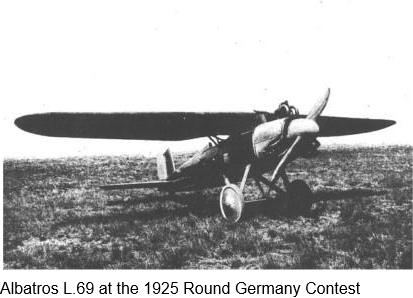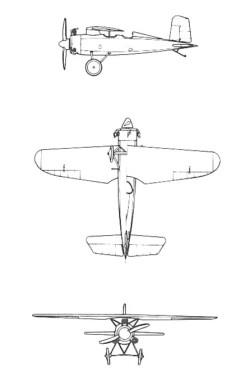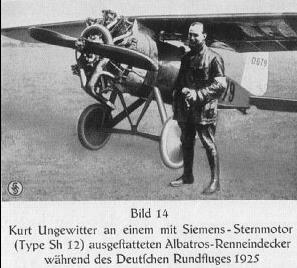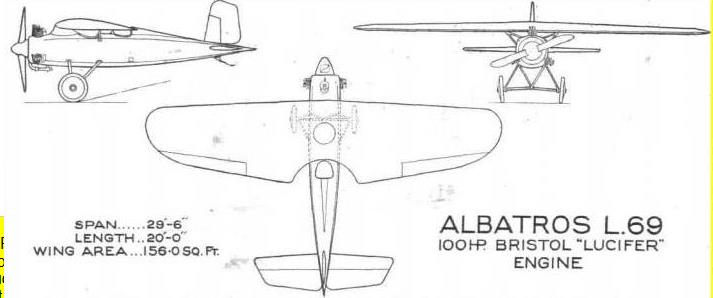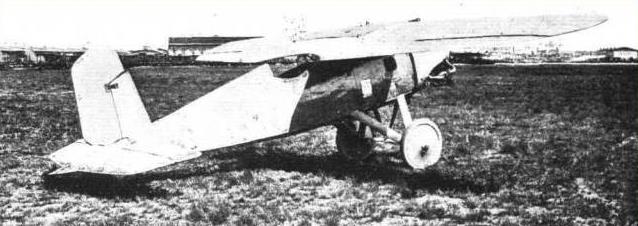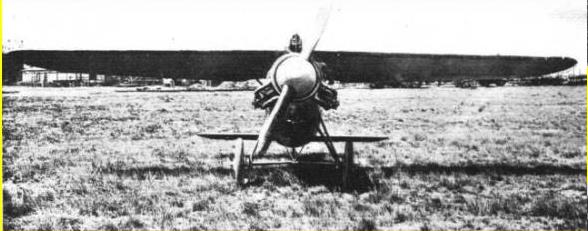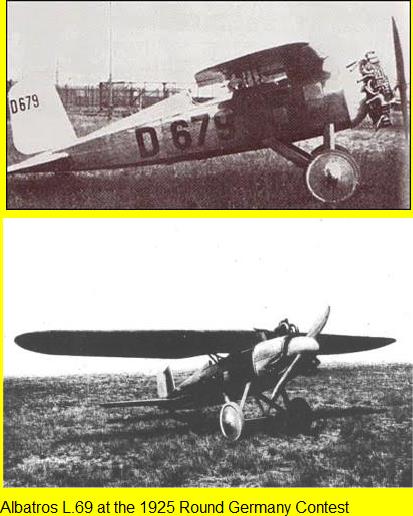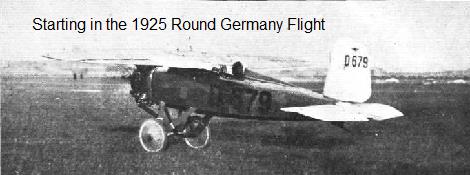The Albatros L 69 was a two-seat German trainer aircraft of the 1920s. Designed by R. Schubert. It was a single-engine parasol-wing monoplane of conventional configuration that seated the pilot and instructor in tandem, open cockpits. In 1925, Albatros' test pilot Kurt Ungewitter won Class D in the Deutsche Rundflug ("Round Germany") in an L 69a, and he was killed in the crash of one two years later. The "Round-Saxony" flight Class D was won by a Bristol-engined Albatros L.69, piloted by Student at an average speed of 165 km/h. Two L 69 was always at Lipezk.
THE ALBATROS L.69
"Bristol "-Engined Monoplane Wins "Round Saxony" Flight ( Flight OCTOBER 29, 1925)
It will be recollected that in the " Round-Germany" flight, which took place in June last, a very promising machine, which did not get an opportunity of really showing what it could do, was the Albatros L.69 monoplane, fitted with Bristol " Lucifer" engine. Such short flights as were made by the machine demonstrated that it was very fast, and, but for the fact that minor defects were discovered at the last moment, there is little doubt that the L.69 would have done well in the Rundflug. These troubles were of a minor character only, such as are to be expected with any new type of machine, and if it had been possible to finish the machine a month or so earlier, these defects would" have been discovered, and doubtless would have been rectified in time for the Rundflug.
That there was nothing much the matter with the machinehas now been amply demonstrated by the fact that in the recent " Round-Saxony " flight, the Albatros L.69, piloted by Student, won first prize in Class D (machines with engines of more than 100 h.p.).
Before giving a description of the Albatros machine, it may be of interest to outline very briefly the nature of the " Round-Saxony " flight. This consisted of two laps of the circuit: Chemnitz-Plaucn-I^ipzig-Grosscnhain-Bautzen-Zittau-Dresden-Chemnitz. The competition was a speed race, but instead of handicapping the various machines, as would probably have been done in this country, the competitors were divided into four classes according to the horse-power of their engines. In Class " 1) " the Albatros L. 69, piloted by Student, completed the two circuits of the course in 6 hours 14 mins. flying time, which corresponds to an average speed of 165 kms./hr. (102-5 m.p.h.). The next-best time was made by another Albatros, a type L.68 biplane with Siemens engine. This machine, owing to the fact that its engine was rated at just under 100 h.p., was classed " l\" and covered the course in 7 hours 57 mins., or at an average speed of 130 kms.hr <http://kms.hr>. (80-75 m.p.h.).
The Udet " Flamingo " was third home with a flying time of 8 hours 28 mins.. a speed of 122 kms./hr. (76 m.p.h.). The Albatros L.69 was designed as a high speed sports monoplane, and, although it is a cantilever monoplane, it has been designed with such high factors of safety that it may be stunted to almost any extent. No figures relating to the actual speed of the " Bristol "-engined machine are available, but it may be taken for granted that the average speed maintained during the " Round-Saxony " flight does not represent anything like the actual top speed of which the machine is capable.
Three-ply wood enters very largely into the construction of the Albatros L.69, this being the material used not only for covering the fuselage, but the greater portion of the wing.
Probably one of the first firms in the world to make such extensive use of three-ply was the Albatros works where as far back as 1913, a two-seater biplane was produced in which the fuselage was ply-wood covered. machines was brought to England in 1914, and was demonstrated at Hendon and Farnborough by the German pioneer pilot, Robert Thelen. More recently, various Albatros single-seater fighters will be remembered from the war period, several being on view once upon a time at the exhibition of captured enemy aircraft at the Agricultural Hall, Islington.
In the L.69 the Albatros designer, Herr Schubert, has applied his long experience of ply-wood construction to a somewhat more refined design, and the L\69 fuselage and wing are very fine examples of ply-wood construction.
The L.69 is a two-seater, with the pilot placed under the trailing edge of the wing, which has been cut away at this point to give access to the cockpit and also to improve the view. The passenger's cockpit is immediately under the wing, and is entered through a trap door in the wing itself.
Thus the passenger is rather closely shut in, and, in case of a crash, his chances of getting out of the wreck would probably not be as good as might be desired. As the machine was designed mainly for racing, this feature of the design can perhaps be regarded as one of those compromises which are permissible in a racing machine.
The monoplane wing is, as already stated, mainly covered with three-ply, although the hinged trailing edge and ailerons are steel tube structures covered with fabric. The whole trailing edge is hinged, and a variable camber gear is incorporated in the design. The ailerons are operated by torque rods and cranks, no cables being employed. An unusual feature in the design is the mounting of the wing on the fuselage, which might be described as " three-point suspension " in that the front spar is supported at one point only by a form of fin built integral with and growing out of the fuselage, while the rear spar has two supports in the form of a steel bracket on each side, raked outwards from the top of the fuselage. The wing can be dismantled by undoing the connections at these three points. The Bristol " Lucifer" engine is mounted or\ a structure oi steel tubes attached to the main fuselage at four points, the supports being so designed that the whole engine mounting can be swung out so as t" give access to the back of the engine. All controls, petrol, leads, etc., pass through the fire-proof bulkhead near the starboard side, so that there are no joints to break when the engine mounting is swung out for inspection. Considerable care has been taken to streamline the engine, and a large spinner is placed over the airscrew boss.
The petrol tank is mounted in the centre section of the monoplane wing, which position gives sufficient height for direct gravity feed to be employed.
The tail of the L.69 is of normal type, except that owing to the fact that the fuselage is provided with a fairing terminating in a point at the rear, the ruddor is wholly abevr the tailplane. The rudder is balanced with the conventional form of horn balance, although this should scarcely be necessary in such a small machine. The tail skid moves with the rudder for steering on the ground. The undercarriage is of conventional type, and is in the form of steel tubes with streamline fairings.
The main dimensions of the Albatros L.69 are shown on the accompanying scale drawings. The only information relating to weights is that the useful load is 201 kgs. (445 lbs.).
The top speed of 170 kms./hr. (105-6 m.p.h.) is mentioned, but we believe that this refers to the machine fitted with the Siemens engine. With the Bristol "Lucifer" it seems probable that a somewhat higher speed is attained, and a rough estimate indicates that the top speed may be in the neighbourhood of 110 m.p.h. The machine is fairly heavily loaded, aud it was noticed at the Rundflug that it took rather a long run to get off. The following fig\ires for climb probably also refer to the Siemens-engined type, and may be slightly better in the case of the machine fitted with Bristol " Lucifer": 500 metres in two minutes, 1,000 metres in four minutes. The landing speed is given as 105 kms./hr. (65 m.p.h.).
| Type |
Werk.Nr |
Registration |
History |
|
|
D-684 |
|
|
10071 |
D-778 |
In Febr. 1928 registered to DVL, Adlershof. Dismantled in April 1929 |
|
|
D-679 |
|
|
10072 |
D-1533 |
Registered to the Albatros company Nov. 1928. Scrapped in Jan. 1931 |
| Type |
Two seat trainer |
a Two seat trainer |
| Engine |
1 Bristol Lucifer |
1 Siemens Sh 12 |
| Dimensions |
Length 6.08 m, height 2.64 m, span 8.06 m, wingarea 10.85 m2 |
Length 6.10 m, height 2.57 m, span 8.06 m, wingarea 14.00 m2 , aspect ratio 6 |
| Weights |
Empty 470 kg, crew 160 kg, fuel 40 kg, flying weight 670 kg |
Empty 480 kg, crew 160 kg, fuel 45 kg, flying weight 685 kg |
| Performance |
Max. speed at sea level 175 km/h, climb to 1000 m 4 min., landing speed 108 km/h, range 340 km, service ceiling 4000 m |
Max. speed at sea level 170 km/h, landing speed 105 km/h, endurance 2 h, climb to 500 m 2 min., to 1000 m 4 min., service ceiling 4000 m |
